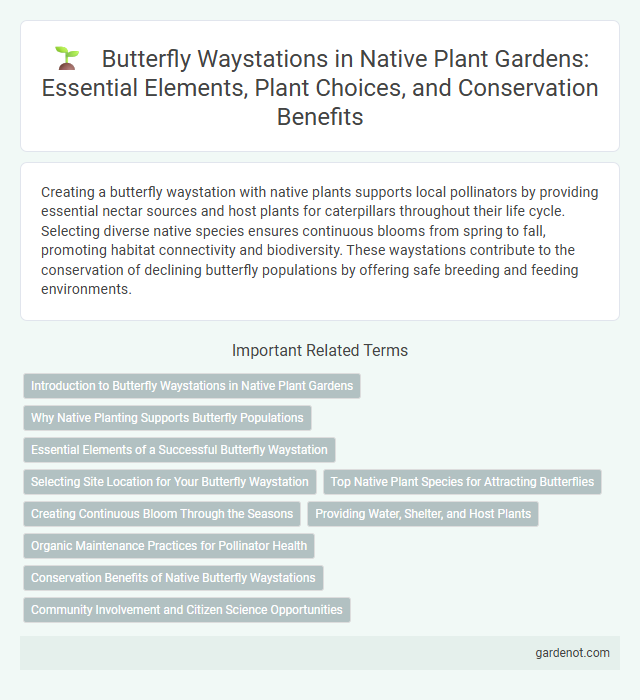Creating a butterfly waystation with native plants supports local pollinators by providing essential nectar sources and host plants for caterpillars throughout their life cycle. Selecting diverse native species ensures continuous blooms from spring to fall, promoting habitat connectivity and biodiversity. These waystations contribute to the conservation of declining butterfly populations by offering safe breeding and feeding environments.
Introduction to Butterfly Waystations in Native Plant Gardens
Butterfly Waystations are specially designed habitats that provide essential resources such as native nectar plants, host plants, and shelter to support butterfly populations throughout their life cycles. These gardens enhance biodiversity by attracting pollinators like Monarchs and Swallowtails, contributing to ecosystem stability and native plant propagation. Incorporating native plants in Butterfly Waystations promotes local wildlife conservation and fosters environmental sustainability in urban and suburban landscapes.
Why Native Planting Supports Butterfly Populations
Native planting supports butterfly populations by providing essential host plants for caterpillars and nectar sources for adult butterflies, ensuring their life cycle can be completed successfully. Native plants co-evolved with local butterfly species, offering the specific nutrients and microhabitats required for breeding and feeding. Establishing butterfly waystations with native flora enhances biodiversity, supports pollination, and helps counteract habitat loss caused by urbanization and agriculture.
Essential Elements of a Successful Butterfly Waystation
A successful Butterfly Waystation requires host plants like milkweed and parsley to support caterpillar development, along with a variety of nectar-rich native flowers such as coneflowers and black-eyed Susans for adult butterflies. Providing continuous bloom throughout the growing season ensures a steady nectar source, while incorporating shelter from wind and areas for sun basking enhances butterfly survival and reproduction. Avoiding pesticides and maintaining a natural habitat with diverse plant heights further promotes a thriving butterfly population.
Selecting Site Location for Your Butterfly Waystation
Choosing an ideal site location for your butterfly waystation requires ample sunlight, at least 6 hours daily, to support nectar-rich native plants and host species. Proximity to water sources and shelter from strong winds create a favorable microclimate that enhances butterfly habitat quality. Ensure soil conditions suit native plant requirements to promote healthy growth and sustain diverse butterfly populations.
Top Native Plant Species for Attracting Butterflies
Milkweed (Asclepias spp.) stands out as a top native plant species vital for attracting monarch butterflies, providing essential nectar and larval food. Purple coneflower (Echinacea purpurea) and Black-eyed Susan (Rudbeckia hirta) offer abundant nectar sources for a wide variety of butterfly species throughout the growing season. Planting a diverse range of native wildflowers like Joe-Pye weed (Eutrochium purpureum) ensures prolonged bloom periods that support butterflies' life cycles and promote local ecosystem health.
Creating Continuous Bloom Through the Seasons
Butterfly waystations that feature native plants create continuous bloom cycles by incorporating a diverse mix of early, mid, and late-season flowering species. This strategic planting supports pollinators year-round, providing consistent nectar and habitat for butterflies throughout spring, summer, and fall. Maintaining seasonal bloom succession also enhances biodiversity and ensures the longevity of the butterfly populations within the ecosystem.
Providing Water, Shelter, and Host Plants
Butterfly waystations play a crucial role in native planting by providing essential resources such as water, shelter, and host plants necessary for butterfly survival and reproduction. Native nectar-rich flowers offer water through dew and hydration points, while shrubs and grasses create protective shelter from predators and harsh weather. Specific host plants like milkweed for monarchs enable butterflies to lay eggs and support caterpillar development, promoting biodiversity and healthy ecosystems.
Organic Maintenance Practices for Pollinator Health
Implementing organic maintenance practices in butterfly waystations supports pollinator health by eliminating synthetic pesticides and chemical fertilizers that harm beneficial insects. Incorporating compost and organic mulches enriches soil quality, promoting native plant resilience and providing nutrient-rich habitats for butterflies and other pollinators. Regular weed management through hand-pulling and natural methods ensures native plants thrive without disrupting the delicate ecosystem balance essential for pollinator survival.
Conservation Benefits of Native Butterfly Waystations
Native butterfly waystations support biodiversity by providing essential host plants and nectar sources that cater to various butterfly species, promoting local ecological balance. These habitats enhance pollination, contributing to the health of surrounding native flora and agricultural crops. Conserving native butterfly waystations reduces reliance on pesticides, fostering a sustainable environment for both pollinators and beneficial insects.
Community Involvement and Citizen Science Opportunities
Butterfly waystations engage communities by providing educational workshops and volunteer planting events that foster local stewardship of native habitats. Participants contribute to citizen science projects by monitoring butterfly populations and reporting sighting data, helping track species diversity and migration patterns. These collaborative efforts support biodiversity conservation while raising public awareness about the importance of native plants for pollinator health.
Butterfly waystation Infographic

 gardenot.com
gardenot.com